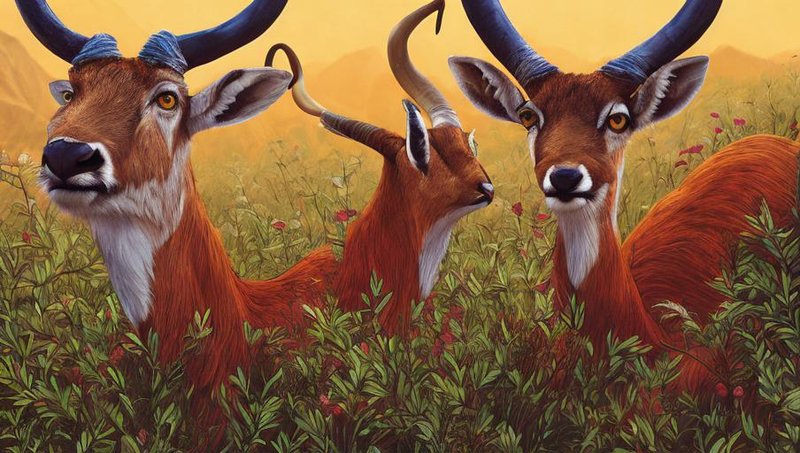
I remember having a conversation with a friend who thought all antelopes lived in herds and were always on the run. But when we dug deeper, we discovered a world where their behavior, habitats, and even their diets are much more complex than we assumed. So, let’s take a moment to clear the fog and debunk some of the most common myths about these elegant mammals.
Myth 1: All Antelopes Are the Same
You might think that all antelopes look alike, but that’s not the case at all! There are over 90 species of antelope, each with its unique traits. Some of the most well-known types include the gazelle, impala, and kudu.
– Size and Appearance: For instance, the kudu can reach up to six feet tall at the shoulder and has impressive spiral horns, while the dik-dik is a tiny creature, standing just about a foot tall. Each species has adapted to its environment, leading to a fascinating variety of shapes, colors, and sizes.
– Herd Behavior: While many antelope species can be social and form herds, others, like the oryx, may prefer a more solitary lifestyle. It’s essential to recognize that each species has its set of characteristics and behaviors, shaped by where they live and what they need to survive.
Here’s the thing: when we lump all antelope together, we miss out on understanding their unique adaptations and the roles they play in their ecosystems.
Myth 2: Antelopes Are Just Fast Animals
Sure, antelopes are known for their incredible speed, but that doesn’t mean that’s all they are! The impala, for example, can run up to 50 miles per hour. However, speed is just one part of their survival toolkit.
– Agility and Maneuverability: What’s interesting is their ability to make sudden turns and jumps to evade predators. They can leap as high as 10 feet! This agility is crucial, especially when facing threats from big cats like lions or cheetahs.
– Habitat and Diet: Antelope don’t just rely on speed; they also have varied diets. Some species are grazers, while others may nibble on shrubs or fruits, depending on the season and their location. This adaptability makes them resilient in different habitats, from grasslands to forests.
So, while speed is a remarkable trait, it’s just one of the many features that help antelopes thrive in the wild.
Myth 3: Antelopes Are Stupid Animals
You might picture antelopes as naïve creatures that don’t know their surroundings. But in reality, they are quite intelligent. In fact, their survival depends on it!
– Social Structures: Many antelope species have complex social structures. For example, female impalas often form close-knit groups, allowing them to watch for predators together. This communal vigilance is a smart strategy to enhance their safety.
– Communication Skills: Antelopes also communicate effectively. They use a variety of sounds, postures, and even facial expressions to convey messages. This form of communication is vital when a threat is near or when they need to signal to one another.
Understanding antelopes’ intelligence can help us appreciate their role in their ecosystems, where they interact with countless other species.
Myth 4: Antelopes Are Always in Danger
While it’s true that many antelope species face threats, not all of them are on the brink of extinction. Some species are thriving.
– Conservation Success: For instance, the springbok, a species of antelope found in southern Africa, has stable populations and is even considered a national symbol of Namibia. Controlled hunting and habitat management have helped maintain healthy numbers.
– Adaptation to Change: Additionally, some antelope species are pretty adaptable. They can thrive in different environments, from open plains to bushy areas. As long as their essential habitats remain intact, many can continue to survive and flourish.
So while conservation efforts are important, it’s essential to recognize that not all antelope species are in critical danger.
Myth 5: Antelopes Are Not Important for Ecosystems
It’s easy to overlook how vital antelopes are to their ecosystems.
– Grazers and Seed Dispersers: As grazers, antelopes help maintain the structure of grasslands. Their grazing can encourage new plant growth and ensure a diverse ecosystem. They also play a crucial role in seed dispersal by munching on fruits and excreting the seeds elsewhere, promoting plant diversity.
– Prey for Predators: Also, antelopes serve as essential prey for many large carnivores. By supporting these predator populations, they help maintain the balance in their ecosystems.
Through these interactions, antelopes contribute to biodiversity and the health of their environments.
Myth 6: Antelopes Can’t Adapt to Climate Change
You might think that the changing climate spells disaster for antelope populations, but many have shown impressive resilience.
– Shifting Habitats: Some antelope species can migrate to find better grazing areas or seek water sources during droughts. This ability to move allows them to adapt to shifting conditions.
– Dietary Flexibility: Many antelopes are herbivorous but can adjust their diets based on what’s available. For example, when grasses are scarce, they may graze on leaves and shrubs. This flexibility can help them survive when conditions change.
While climate change poses challenges, it’s important to recognize the adaptability of these animals. They have evolved to survive in various conditions, and many are showing they can face new challenges, too.
Myth 7: Antelopes Are Just for Show
Finally, you might think antelopes are simply beautiful creatures, but they also have critical roles in various cultures and ecosystems.
– Cultural Significance: In many cultures, antelopes are symbols of grace and freedom. They often appear in art, folklore, and even sports teams’ mascots. This cultural significance helps highlight conservation efforts and raises awareness about their importance.
– Economic Impact: Hunting and eco-tourism based on antelope viewing also contribute to local economies. Managed correctly, this can lead to sustainable practices that benefit both the animals and the people living in those regions.
Antelopes are so much more than just picturesque animals; they have profound impacts that ripple through ecosystems and human societies.
In conclusion, it’s easy to fall for the myths and misconceptions about antelopes, especially when they seem to get repeated often. But the truth is that these creatures are diverse, intelligent, and important for our planet. By understanding them better, we can appreciate their role and work towards their conservation. So next time you spot one of these lovely animals, you’ll know just how special they truly are!

